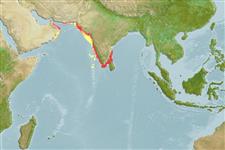>
Clupeiformes (Herrings) >
Dorosomatidae (Gizzard shads and sardinellas)
Etymology: Sardinella: Latin and Greek, sarda = sardine; name related to the island of Sardinia; diminutive (Ref. 45335).
More on author: Valenciennes.
Environment: milieu / climate zone / depth range / distribution range
экология
морской; мигрирует в океане (Ref. 51243); пределы глубины 20 - 200 m (Ref. 28016). Tropical; 25°N - 7°N, 57°E - 81°E (Ref. 54872)
Indian Ocean: northern and western parts only, Gulf of Aden, Gulf of Oman, but apparently not Red Sea or the Persian Gulf, eastward to southern part of India, on eastern coast to Andhra; possibly to the Andaman Islands. Thus, studies pertaining to this species from the Philippines or Indonesia probably refer to Sardinella lemuru.
Length at first maturity / Size / Вес / Возраст
Maturity: Lm 16.3 range ? - ? cm
Max length : 23.0 cm SL самец/пол неопределен; (Ref. 188); common length : 20.0 cm SL самец/пол неопределен; (Ref. 188); наибольший вес (опубликованные данные): 200.00 g (Ref. 4883); наибольший возраст (опубликованны данные): 3 годы (Ref. 3689)
колючие лучи спинного плавника (общее число): 0; членистые (мягкие) лучи спинного плавника (общее число): 13-21; колючие лучи анального плавника 0; членистые (мягкие) лучи анального плавника: 12 - 23; позвонки: 45 - 49. Body sub-cylindrical; a faint golden spot behind gill opening, followed by a faint golden mid-lateral line; a distinct black spot at hind border of gill cover (absence of pigment). Distinguished from all clupeids in the northern Indian Ocean by its pelvic fin ray count of i 8; from S. neglecta and S. lemuru by its longer head and more lower gill rakers. No prominent keel. See also Refs. 3683, 818 and 393 .
Coastal pelagic (Ref. 68964). Forms schools in coastal waters and strongly migratory. Feeds mainly on phytoplankton (especially diatoms) and small crustaceans (Ref. 30573). Breeds once a year off western coasts of India when temperatures and salinity are low during the southwest monsoon months. Spawning peaks in August-September. Occurs at temperatures of 22.0-28.0 °C (Ref. 3689). Marketed fresh, dried and dried-salted. Also sold smoked and canned (Ref. 9987). Also made into fish meal and fish balls.
Spawning usually takes place at night (Ref. 810).
Whitehead, P.J.P., 1985. FAO Species Catalogue. Vol. 7. Clupeoid fishes of the world (suborder Clupeoidei). An annotated and illustrated catalogue of the herrings, sardines, pilchards, sprats, shads, anchovies and wolf-herrings. FAO Fish. Synop. 125(7/1):1-303. Rome: FAO. (Ref. 188)
Статус Красного Списка МСОП (Ref. 130435)
Угроза для людей
Harmless
Использование человеком
рыболовство: важный объект промысла
дополнительная информация
соавторыизображенияStamps, Coins Misc.звукиCiguateraскоростьтип плаванияжаберная областьOtolithsмозгзрение
инструменты
Специальные отчеты
Скачать в формате XML
ресурсы в Интернет
Estimates based on models
Preferred temperature (Ref.
123201): 22.1 - 26.7, mean 24.7 °C (based on 63 cells).
Phylogenetic diversity index (Ref.
82804): PD
50 = 0.5000 [Uniqueness, from 0.5 = low to 2.0 = high].
Bayesian length-weight: a=0.00794 (0.00661 - 0.00954), b=3.02 (2.99 - 3.05), in cm total length, based on LWR estimates for this species (Ref.
93245).
Trophic level (Ref.
69278): 2.4 ±0.22 se; based on food items.
Generation time: 1.2 (1.1 - 2.0) years. Estimated as median ln(3)/K based on 19
growth studies.
устойчивость к внешним воздействиям (Ref.
120179): средний (среднего размера), минимальное время удвоения популяции 1.4-4.4 года (K=0.5-1.4; tm=2; tmax=3; Fec=19,028).
Prior r = 0.57, 95% CL = 0.37 - 0.85, Based on 2 stock assessments.
Fishing Vulnerability (Ref.
59153): Low vulnerability (17 of 100).
Climate Vulnerability (Ref.
125649): Moderate to high vulnerability (53 of 100).
Nutrients (Ref.
124155): Calcium = 243 [124, 369] mg/100g; Iron = 1.94 [1.13, 3.42] mg/100g; Protein = 20.2 [19.2, 21.2] %; Omega3 = 0.302 [0.145, 0.589] g/100g; Selenium = 130 [68, 257] μg/100g; VitaminA = 22.9 [6.9, 69.7] μg/100g; Zinc = 1.3 [0.9, 1.8] mg/100g (wet weight); based on
nutrient studies.
